
Greenhouse and Energy Minimum Standards (Swimming Pool Pump-units) Determination 2021
I, Tim Wilson, Assistant Minister to the Minister for Industry, Energy and Emissions Reduction, make the following determination.
Dated 17 December 2021
Tim Wilson
Assistant Minister to the Minister for Industry, Energy and Emissions Reduction
Contents
Part 1 —Preliminary
1 Name
2 Commencement
3 Authority
4 Definitions—standards referred to in this Determination
5 Definitions—other expressions used in this Determination
6 Classification of pump-units – meaning of single, two, multi and variable speed
7 Applicable definitions and applicable versions of standards and documents incorporated into standards
8 Families of models
9 Product category
Part 2 —Products covered by Determination
10 Purpose of Part
11 Class of product that is covered by this Determination
Part 3 —GEMS level requirements
Division 1 —Preliminary
12 Purpose of Part
13 Meaning of relevant MEPS level
Division 2 —GEMS level requirements (MEPS levels)
14 GEMS level requirements (MEPS levels) for a product
Division 3—Testing requirements
15 Testing requirements
16 Rounding
Part 4 —GEMS labelling requirements
Division 1 —Preliminary
17 Purpose of Part
18 Interpretation
Division 2 —Requirements relating to energy labels
Subdivision 1—When energy labels are required or permitted
19 When energy labels are required or permitted
20 Manner of communication of energy rating labels
Subdivision 2—Calculation of amounts for energy rating label and energy rating icon
21 Calculating Energy Consumption
22 Calculating the star rating
Division 3 —Other GEMS labelling requirements
23 Advertising material
Division 4—Testing requirements
24 Testing requirements
25 Rounding
Division 5—Labelling requirements if this Determination is revoked
26 Impact of replacement determination
Part 5 —Other GEMS requirements
Division 1 —Preliminary
27 Purpose of Part
Division 2 —Testing requirements
28 Other requirements – reporting sound testing results
29 Other requirements - testing requirements
Schedule 1 —Format of energy rating label
1 Interpretation
2 Meaning of certain details in the diagrams
3 The energy rating label
4 Content of the star arch (element a)
5 Content of the energy rating strip (element b)
6 Content of the joint government and industry program text (element c)
7 Content of the pump brand, model and classification text (element d)
8 Content of the energy consumption text (element e)
9 Content of the text describing the test standard (element f)
10 Content of compare models text (element g)
11 Colours and fonts for the energy rating label
12 Physical layout requirements for the label
Schedule 2—Format of energy rating icon
1 Interpretation
2 Meaning of certain details in the diagrams
3 The energy rating icon
4 Content of the star arch
5 Content of the energy rating text
6 Colours and fonts for the energy rating icon
7 Physical layout requirements for the icon
COPYRIGHT
© 2021 Commonwealth of Australia
With the exception of the Commonwealth Coat of Arms and any trademarks owned by the Commonwealth (including the energy rating labels and the energy rating icons), this Determination is licensed under the Creative Commons Attribution-Non-Commercial-ShareAlike 4.0 International Licence (Creative Commons Attribution Licence). To view a copy of this licence, visit https://creativecommons.org/licenses/by-nc-sa/4.0/.
You are free to copy and communicate this Determination (apart from the excluded material indicated above) so long as you do so for non-commercial purposes, attribute the Commonwealth of Australia, and license any derivative works under the same licence as the original (indicating any modifications), in accordance with the Creative Commons Attribution Licence (CC BY‑NC‑SA). For clarity, you are permitted to use this Determination in the above manner to comply with your obligations under it.
Part 1—Preliminary
1 Name
This instrument is the Greenhouse and Energy Minimum Standards (Swimming Pool Pump-units) Determination 2021.
2 Commencement
This Determination commences and comes into force on 1 October 2022.
3 Authority
This Determination is made under section 23 of the Greenhouse and Energy Minimum Standards Act 2012.
4 Definitions—standards referred to in this Determination
Note: Subsection 7(2) provides that the applicable version of each standard referred to in the section is the version that existed at the date this Determination was made.
In this Determination:
AS 5102.1-2019 means Australian Standard 5102.1:2019 Performance of household electrical appliances – Swimming pool pump-units, Part 1: Measurement of energy consumption and performance.
Note: AS 5102.1-2019 is available from Standards Australia Limited.
AS 2706-2003 means Australian Standard 2706-2003 Numerical values – Rounding and interpretation of limiting values.
Note: AS 2706-2003 is available from Standards Australia Limited.
5 Definitions—other expressions used in this Determination
In this Determination:
Act means the Greenhouse and Energy Minimum Standards Act 2012.
Australian Standard means a standard that is published by Standards Australia Limited denoted by the letters “AS” and identifying numbers and letters.
energy label—see section 18.
energy rating icon—see section 18.
energy rating label—see section 18.
GEMS retail premises—see section 18.
MEPS means Minimum Energy Performance Standards.
nameplate input current means, in relation to a pump-unit, the electrical input current as shown on the pump unit rating label, in amps.
nameplate input power means, in relation to a pump-unit, either:
- the electrical input power as shown on the pump unit rating label, in watts; or
- if the electrical input power is not shown on the pump unit rating label - the nameplate input current multiplied by 230V.
nameplate rating means, in relation to a pump-unit, the electrical input voltage, current and power as shown on the pump unit rating label.
pool means any of the following:
- a swimming pool; or
- a swimming pool and a spa pool that share a water circulation system; or
- a spa pool.
pump means the part of a pump-unit which converts mechanical energy provided by the electric motor into hydraulic energy, which is the sum of the water potential energy and kinetic energy.
pump-unit means a combination of electric motor, pump, hair and lint pot, controller and all plumbing fittings/filters supplied with the pump unit.
product class—see section 11.
single-phase—a product is single‑phase if all components that require an external power supply require only single-phase power.
standard means Australian Standard, an Australian/New Zealand Standard, an International Electrotechnical Commission (IEC) Standard, an Institute of Electrical and Electronics Engineers (IEEE) standard or any other equivalent document.
spa bath means a water-retaining structure designed for human use, which holds 680 litres of water or less, and which incorporates, or is connected to, equipment capable of filtering and/or heating the water and injecting air bubbles or water into the bath under pressure to cause water turbulence.
spa pool means a water-retaining structure designed for human use, which holds more than 680 litres of water, and that incorporates, or is connected to, equipment capable of filtering and/or heating that water and injecting air bubbles or water into the pool under pressure to cause water turbulence.
swimming pool means a water-retaining structure designed for human use, which holds more than 680 litres of water and which incorporates, or is connected to, equipment capable of filtering and/or heating the water, and includes any waterslide, wave pool, hydrotherapy pool or other similar structures, but does not include:
- a spa pool; or
- a spa bath (unless part of the pool system); or
- a tidal pool or other similar structure where water flows in and out of the structure according to the operation of natural forces.
6 Classification of pump-units – meaning of single, two, multi and variable speed
In this Determination:
a pump-unit is single speed if it has a single discrete nominal motor speed that is fixed by the manufacturer.
a pump-unit is two speed if it has two discrete nominal motor speeds that are fixed by the manufacturer. The speed settings may be selectable by the user or installer or control system, but the user or installer or control system cannot change the speed assigned by the manufacturer to each discrete speed setting.
a pump-unit is multi speed if it has three or more discrete nominal motor speeds that are fixed by the manufacturer. The speed settings may be selectable by the user or installer or control system, but the user or installer or control system cannot change the speed assigned to each discrete speed setting.
a pump-unit is variable speed if it has continuously variable speeds, where the speed may be set or reset by the user or installer or control system.
7 Applicable definitions and applicable versions of standards and documents incorporated into standards
Applicable definitions of terms or phrases
- If there is inconsistency in the definitions of words or expressions, the words or expressions will be interpreted in the following order of priority, to the extent of any inconsistency:
- the Act;
- this Determination;
- a standard referred to in this Determination, or another standard referred to in such a standard.
Applicable version of documents incorporated into standards
- For the purposes of this Determination the applicable version of any:
- standard; or
- other document that:
- is referred to in a standard under the heading “Referenced Documents” or under an equivalent heading; and
- must be applied to give effect to this Determination or a standard referred to in this Determination;
- is the version of the standard or other document that existed at the date this Determination was made.
Note: For example, the applicable versions of AS 5102.1-2019 is the version that existed at the date this Determination was made.
8 Families of models
- For section 28 of the Act, for a particular product class covered by this Determination, two or more models are in the same family of models if:
- they are members of a family that has been declared to the GEMS Regulator; and
- the requirements of this section are satisfied in relation to the models and the family.
- For subsection (1), the models must:
- have the same energy performance characteristics relevant to complying with Part 3, including, but not limited to:
- motor type; and
- nameplate rating; and
- pump-unit classification; and
- have the same physical characteristics that are relevant to complying with Part 3; and
- be included on a single test report which was prepared prior to the application for registration for the model being made under section 41 of the Act.
- For subsection (1), a family must not contain more than 10 models.
9 Product category
For section 29 of the Act, the products covered by this Determination are category A products.
Part 2—Products covered by Determination
10 Purpose of Part
For subsections 23(1) and 23(2) of the Act, this Part specifies:
(a) the product class that is covered by this Determination; and
(b) classes of products that are not covered by this Determination.
11 Class of product that is covered by this Determination
(1) This Determination covers pump‑units that are:
(a) single-phase; and
(b) designed for use in connection with a pool for the circulation of water through pool filters, sanitisation devices, cleaning devices, water heaters (including solar) or through spa or jet outlets or other features forming part of the pool; and
(c) capable of a flow rate equal or greater than 120 litres per minute; and
(d) within the specified nameplate input power as described in Table 1.
Table 1 – Nameplate rating range
Pump classification | Nameplate input power range (watts) | Nameplate input current range (amps) |
| |
Single speed | 600 to 1700 | 2.6 to 7.4 |
Two speed, multi speed and variable speed | 600 to 3450 | 2.6 to 15 |
(2) This Determination does not cover pump-units that are:
(a) capable of a maximum flow rate that is less than 120 litres per minute; or
(b) single speed pump-units with nameplate input power of less than 600 watts or more than 1700 watts; or
(c) two speed, multi speed or variable speed pump-units with nameplate input power of less than 600 watts or more than 3450 watts.
Part 3—GEMS level requirements
Division 1—Preliminary
12 Purpose of Part
For paragraph 24(1)(a) of the Act, this Part specifies GEMS level requirements in accordance with section 25 of the Act for the product class covered by this Determination.
13 Meaning of relevant MEPS level
in this Part:
1) the relevant MEPS level, for a product means the BaselineWEF calculated in accordance with the following formula:
BaselineWEF = 
where:
ln is the natural logarithm.
nameplate input power is the electrical input power as shown on the pump unit rating label, in watts. If the electrical input power is not shown on the pump unit rating label - the nameplate input current multiplied by 230V.
WEF is the weighted energy factor.
Division 2—GEMS level requirements (MEPS levels)
14 GEMS level requirements (MEPS levels) for a product
The WEF for a product covered by this Determination must be greater than or equal to the relevant MEPS level, where WEF or weighted energy factor means the weighted average of the volume of water pumped in litres per watt hour of electrical energy consumed by the pump-unit, calculated in accordance with clause 3.3 of AS 5102.1‑2019.
Division 3—Testing requirements
15 Testing requirements
For paragraph 25(b) of the Act, the testing requirements for the purposes of this Part are those specified in sections 3 to 7 of AS 5102.1-2019 (except for those specified in clause 5.9 of AS 5102.1-2019).
16 Rounding
Unless otherwise stated, numbers must be rounded and recorded to five significant figures in accordance with AS 2706-2003.
Part 4—GEMS labelling requirements
Division 1—Preliminary
17 Purpose of Part
For paragraph 24(1)(b) of the Act, this Part specifies GEMS labelling requirements in accordance with section 26 of the Act for the product class covered by this Determination.
18 Interpretation
In this Determination:
energy label in relation to a product, means a label that is, or purports to be, designed to assist consumers to compare the energy efficiency and energy consumption of products covered by this Determination.
energy rating icon means an energy label:
(a) that complies with this Division; and
(b) whose content and format complies with the requirements of Schedule 2.
energy rating label means an energy label:
(a) that complies with this Division; and
(b) whose content and format complies with the requirements of Schedule 1.
GEMS retail premises means any premises:
(a) that are open to the public on a regular basis; and
(b) that are used for, or in connection with, the supply of one or more GEMS products; and
(c) at which products that are covered by this Determination are displayed for the purposes of retail supply or offers of retail supply.
Note: Such premises will be a GEMS business premises within the meaning of section 5 of the Act, and in particular, will satisfy paragraph (a) of the definition of that term.
Division 2—Requirements relating to energy labels
Note: This Division applies only in relation to retail supplies and offers of retail supply, and does not regulate wholesale supplies or offers of wholesale supply.
Subdivision 1—When energy labels are required or permitted
19 When energy labels are required or permitted
When energy rating labels are required
(i) An energy rating label must be communicated in connection with a retail supply, or offer of retail supply, of a product that:
- is covered by this Determination (see section 11); and
- is supplied, or offered for supply, at a GEMS retail premises (see section 18).
When energy rating icons are permitted
(2) An energy rating icon may, but need not, be used in an online or print advertisement for a product covered by this section.
20 Manner of communication of energy rating labels
(1) If an energy rating label is communicated under subsection 19(1), it must:
- be adhered to, be printed on, or be part of; or
- be included in;
the packaging of each unit of the product.
(2) If an energy rating label is communicated under subsection 19(1), and one or more units or packages of the product, or one or more units of another product that looks like or is otherwise represented as being the product, are displayed at a GEMS retail premises:
- at least one energy rating label must be clearly visible in relation to the display; and
- if all units on display are packaged—an energy rating label must be adhered to, be printed on, or be part of, the outside of each package; and
- if one or more units are not packaged:
(i) for each unpackaged unit—an energy rating label must:
(A) be adhered to, be printed on, or be part of, the unit; or
(B) be attached, in the form of a double‑sided swing tag or a non‑rotating single‑sided swing tag, to the unit; and
(ii) for each packaged unit (if any)—the energy rating label may, but need not, be adhered to, be printed on, be part of, the unit’s package.
(3) For subsection (2), if a display relating to the product includes a model of the product, a non‑functioning display unit, or another item that represents a unit of the product, paragraph (2)(c) applies as if it were an unpackaged unit.
Subdivision 2—Calculation of amounts for energy rating label and energy rating icon
21 Calculating Energy Consumption
The energy consumption of a product is the sum of the projected annual energy consumption (PAEC) values for each unit tested, divided by the number of units tested. The projected annual energy consumption is calculated as specified in section 3 of AS 5102.1-2019.
22 Calculating the star rating
(1) The star rating index (SRI) for a product is given by the following formula:

where:
ln is the natural logarithm.
WEFaverage is the sum of the WEF values for each unit tested, divided by the number of units tested.
BaselineWEF = 
nameplate input power is the electrical input power as shown on the pump unit rating label, in watts. If the electrical input power is not shown on the pump unit rating label - the nameplate input current multiplied by 230V.
WEF is the weighted energy factor.
(2) The star rating for a product is derived from the SRI according to the following table:
Derivation of star rating |
| SRI | 1.5 | 1 |
1.5 | SRI | 2 | 1 ½ |
2 | SRI | 2.5 | 2 |
2.5 | SRI | 3 | 2 ½ |
3 | SRI | 3.5 | 3 |
3.5 | SRI | 4 | 3 ½ |
4 | SRI | 4.5 | 4 |
4.5 | SRI | 5 | 4 ½ |
5 | SRI | 5.5 | 5 |
5.5 | SRI | 6 | 5 ½ |
6 | SRI | 7 | 6 |
7 | SRI | 8 | 7 |
8 | SRI | 9 | 8 |
9 | SRI | 10 | 9 |
10 | SRI | | 10 |
Division 3—Other GEMS labelling requirements
23 Advertising material
- Sales literature that is provided at the time a product is supplied, or offered for supply, may include the energy rating icon as described in Schedule 2.
- Online or print advertising may include the energy rating icon as described in Schedule 2.
- Sales literature and online or print advertising relating to a product covered by this Determination must not include an energy rating label.
Division 4—Testing requirements
24 Testing requirements
Subject to subsection (2), for paragraphs 26(1)(c) of the Act, the testing requirements for the purposes of this Part are those specified in sections 3 to 7 of AS 5102.1-2019 (except for those specified in clause 5.9 of AS 5102.1-2019).
25 Rounding
Unless otherwise stated, numbers must be rounded and recorded to five significant figures in accordance with AS 2706-2003.
Division 5—Labelling requirements if this Determination is revoked
26 Impact of replacement determination
A GEMS labelling requirement of this Determination (the revoked requirement) is taken to be complied with if:
- this Determination is revoked in accordance with paragraph 35(1)(a) of the Act; and
- another GEMS determination (the replacement determination) is made in accordance with paragraph 35(1)(b) of the Act; and
- a transitional GEMS labelling requirement (the replacement requirement) of the replacement determination provides that, if the replacement requirement is complied with, the revoked requirement is taken to be complied with.
Part 5—Other GEMS requirements
Division 1—Preliminary
27 Purpose of Part
For subsection 24(2) of the Act, this Part specifies other requirements in accordance with section 27 of the Act for the product classes covered by this Determination.
Division 2—Testing requirements
28 Other requirements – reporting sound testing results
- For paragraph 27(1)(c) of the Act, the results of sound testing of a product (conducted in accordance with the requirements of s 29), including the sound power of a product, must be included in an application for the registration of a model or models in relation to a product class covered by this Determination.
- In this section, the sound power means the A-weighted sound power measured in accordance with clause 5.9 of AS 5102.1-2019.
29 Other requirements - testing requirements
For paragraph 27(1)(e) of the Act, the testing requirements for the purposes of this Part are those specified in sections 3 to 7 of AS 5102.1-2019.
Schedule 1—Format of energy rating label
1 Interpretation
In this Schedule:
diagram 1—see subsection 3(3) of this Schedule.
diagram 2—see subsection 11(4) of this Schedule.
diagram 3—see subsection 12(2) of this Schedule.
diagram 4—see subsection 12(3) of this Schedule.
2 Meaning of certain details in the diagrams
In the diagrams contained in this Schedule, numbers, model details and star ratings are for illustrative purposes only; the actual numbers, model details and star ratings for the energy rating label for a particular product must be calculated in accordance with Part 4 of this Determination and as specified in this Schedule.
3 The energy rating label
- Unless this Schedule provides otherwise:
- the energy rating label for a product must include each element mentioned in subsection (2); and
- the elements must contain the objects and text shown in diagram 1; and
- the elements, and the objects and text within them, must be arranged as shown in diagram 1; and
- the elements of the energy rating label for a product must be in the colour and font as shown in diagram 2, the dimensions as described in diagram 3 and the angles as described in diagram 4.
- For this Schedule, the components of an energy rating label for a product are the following, as identified by letter in diagram 1:
- the star arch – 1 to 10 stars (element a);
- the energy rating strip (element b);
- the joint government and industry program text (element c);
- the pump brand, model and classification text (element d);
- the energy consumption text, expressed in kWh per year (element e);
- the text describing the test standard (element f);
- the compare models text (element g).
(ii) Diagram 1:
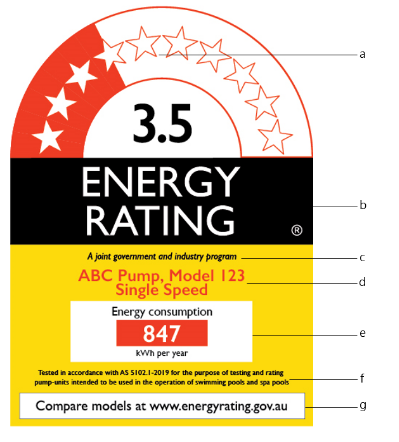
4 Content of the star arch (element a)
(1) The star arch must be set out as shown in diagram 1. The star arch is to include ten white stars, with a red background indicating the applicable star rating as calculated under section 22 of this Determination. For example, if the rating is 3 ½ stars then the rating star aligns halfway through the fourth star in the band. Diagram 1, for example, displays a 3 ½ star product.
(2) The applicable star rating must be listed numerically immediately below the star arch. For example, in Diagram 1, the rating is 3 ½ stars so the number 3.5 must be displayed.
(3) The angle of the stars are described in diagram 4 and the colour is described in diagram 2.
5 Content of the energy rating strip (element b)
The energy rating strip text must be set out as shown in diagram 1. The font size and colour is described in diagram 2.
6 Content of the joint government and industry program text (element c)
The joint government and industry program text must be set out as shown in diagram 1. The font size and colour is described in diagram 2.
7 Content of the pump brand, model and classification text (element d)
(1) The pump, model and speed text must be set out as shown in diagram 1 and must display the product’s:
- pump brand;
- pump model; and
- pump classification.
(2) The font size and colour is described in diagram 2.
8 Content of the energy consumption text (element e)
The energy consumption text, expressed in kWh per year, must be set out as shown in diagram 1 and must display the product’s energy consumption, as calculated under section 21 of this Determination. The font size and colour is described in diagram 2.
9 Content of the text describing the test standard (element f)
The text describing the test standard must be set out as shown in diagram 1. The font size and colour is described in diagram 2 and section 11 of this Schedule.
10 Content of compare models text (element g)
The compare models website text must be set out as shown in diagram 1. The font size and colour is described in diagram 2 and section 11 of this Schedule.
11 Colours and fonts for the energy rating label
- The energy rating label must be printed on a white background using the following colours in the elements as shown in diagram 2.
- for red—Pantone Warm red;
- for yellow—Pantone 116;
- for black—Pantone Black.
- The entire label must be in only one font, which may be any one of the following:
- Gill Sans (preferred);
- Humanist 521;
- Hammersmith.
- The text in an energy rating label must be of the font size and colour shown in diagram 2. All type weights regular unless otherwise specified.
(4) Diagram 2:
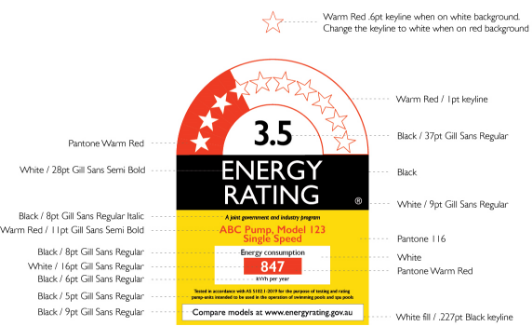
12 Physical layout requirements for the label
- The components in an energy rating label must be laid out as shown in diagram 3 and 4.
- Diagram 3:
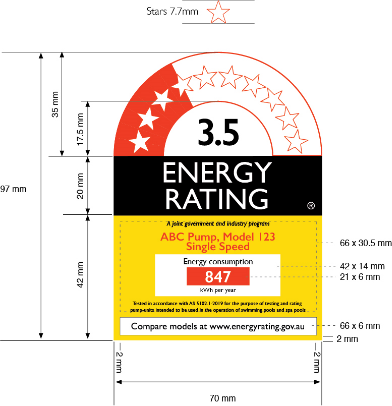
(3) Diagram 4:
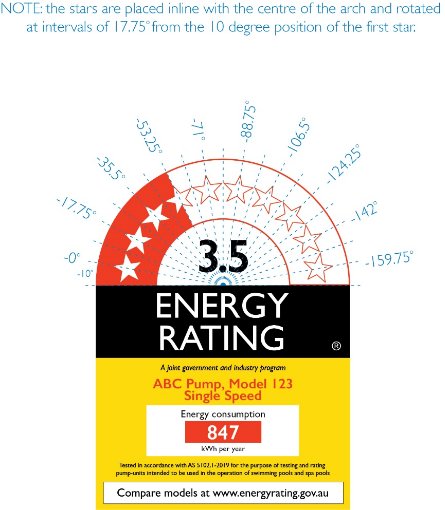
Schedule 2—Format of energy rating icon
1 Interpretation
In this Schedule:
diagram 5—see subsection 3(3) of this Schedule.
diagram 6—see subsection 4(3) of this Schedule.
diagram 7 –see subsection 4(4) of this Schedule
2 Meaning of certain details in the diagrams
In the diagrams in this Schedule, numbers and star ratings are for illustrative purposes only. The actual numbers and star ratings for the energy rating icon for a particular product must be calculated in accordance with Part 4 of this Determination and as specified in this Schedule.
3 The energy rating icon
- Unless this Schedule provides otherwise:
- the energy rating icon for a product must include each element mentioned in subsection (2); and
- the elements must contain the objects shown in diagram 5; and
- the elements, and the objects within them, must be arranged as shown in diagram 5.
- For this Schedule, the elements of an energy rating icon for a product are the following, as identified in diagram 5:
- the star arch – 1 to 10 stars;
- the star rating number;
- the energy rating strip; and
- the yellow strip containing the energy rating website.
(3) Diagram 5:

4 Content of the star arch
- The star arch must be set out as shown in diagram 5. The star arch is to include ten white stars, with a red background indicating the applicable star rating as calculated under section 22 of this Determination. For example, if the rating is 3 ½ stars then the rating star aligns with the halfway through the fourth star in the band. Diagram 5, for example, displays a 3 ½ star product.
- The applicable star rating must be listed numerically immediately below the star arch. For example, in Diagram 5, the rating is 3 ½ stars so the number 3.5 must be displayed.
(3) The angle of the stars are described in diagram 6 and the colour is described in diagram 5. Proportionate measurements are described in diagram 7.
(4) Diagram 6:
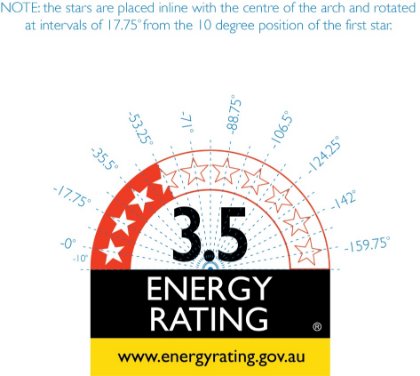
(4) Diagram 7:
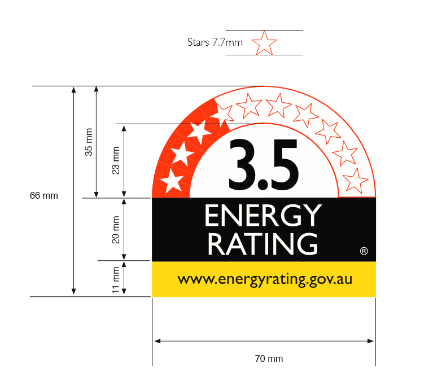
5 Content of the energy rating text
The energy rating text, font size, and colour must be set out as shown in diagram 5.
6 Colours and fonts for the energy rating icon
(1) The energy rating icon must be printed on a white background using the following colours in the elements as shown in diagram 5.
- for red—Pantone Warm red;
- for yellow—Pantone 116;
- for black—Pantone Black
(2) For an energy rating icon appearing in digital media, the following RGB or equivalent colours must be used:
(a) for red: 238 – 59 - 36
(b) for yellow: 252 – 217 – 11
(c) for black: 0 – 0 – 0
(3) The entire energy rating icon must be in only one font, which may be any one of the following:
(a) Gill Sans (preferred);
(b) Humanist 521;
(c) Hammersmith.
(4) The text in an energy rating icon must be of the font size and colour shown in diagrams 5 to 7. All type weights regular unless otherwise specified.
7 Physical layout requirements for the icon
- The components in an energy rating icon must be laid out as shown in diagrams 5 to 7.
- Subject to this section, an energy rating icon may be of any size. The dimensions of the icon, and of the text in the icon, must be proportional to the dimensions of the icon as illustrated in diagram 7.








